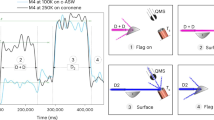Abstract
The dependence of the wavelength of peak absorption of dust grains on the grain size is investigated analytically by using an oscillator model for the absorption band. The peak wavelength of a weak absorption band is much less sensitive to the grain size than that of a strong band. This is explained by the fact that the surface mode, which is excited in the strong absorption band, is not raised in the weak absorption band. A quenched carbonaceous composite (QCC) synthesized from hydrocarbon plasma is found to have a weak absorption band at 220 nm. The absorption peak wavelength of the QCC grains falls well in the range of 217±7 nm even if the grain size runs from 5 to 100 nm. This is compatible with the observed constancy of the 220 nm hump (217±5 nm). By contrast, the absorption peak of graphite grains, which have a strong band around 280 nm and have been investigated as candidates for the hump, is very sensitive to the grain size. A quite narrow range of the grain size is required to account for the observed 220 nm feature. A weak absorption model, such as the QCC grains, is suggested to be a more likely candidate for the 220 nm extinction hump than a strong absorption model, such as graphite grains.
Similar content being viewed by others
References
Bohren, C. F. and Huffman, D. R.: 1983,Absorption and Scattering of Light by Small Particles, Wiley, New York.
Donn, B.: 1968,Astrophys. J. 152, L129.
Gilra, D. P.: 1971,Nature 229, 237.
Gilra, D. P.: 1972, in A. D. Code (ed.),The Scientific Results from the Orbiting Astronomical Observatory OAO-2, NASA SP-301, p. 295.
Hecht, J.: 1981,Astrophys. J. 246, 794.
Sakata, A., Wada, S., Okutsu, Y., Shintani, H., and Nakada, Y.: 1983,Nature 301, 493.
Savage, B. D.: 1975,Astrophys. J. 199, 92.
Savage, B. D. and Mathis, J. S.: 1979,Ann. Rev. Astron. Astrophys. 17, 73.
Stecher, T. P. and Donn, B.: 1965,Astrophys. J. 142, 1681.
Taft, E. A. and Philip, H. R.: 1965,Phys. Rev. A 138, 197.
Wickramasinghe, N. C. and Guillaume, C.: 1965,Nature 207, 366.
Author information
Authors and Affiliations
Rights and permissions
About this article
Cite this article
Onaka, T., Nakada, Y., Tanabe, T. et al. A quenched carbonaceous composite (QCC) grain model for the interstellar 220 NM extinction hump. Astrophys Space Sci 118, 411–413 (1986). https://doi.org/10.1007/BF00651159
Received:
Issue Date:
DOI: https://doi.org/10.1007/BF00651159




